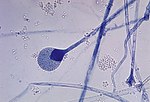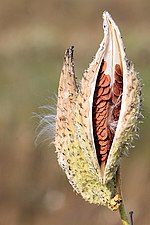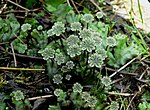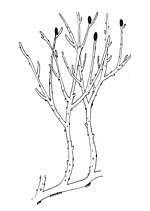Sporangium (redirect from Sporangia)
Ancient Greek σπορά (sporá) 'seed' and ἀγγεῖον (angeîon) 'vessel'); pl.: sporangia) is an enclosure in which spores are formed. It can be composed of a single...
9 KB (901 words) - 13:05, 26 August 2024
Rhizopus (redirect from Rhizopus sporangia)
sporangiospores are produced inside a spherical structure, the sporangium. Sporangia are supported by a large apophysate columella atop a long stalk, the sporangiophore...
7 KB (631 words) - 23:53, 6 July 2024
commonly known as the chocolate tube slime, is a species of slime mold. The sporangia are dark purplish brown, smooth, dry, 10–20 mm tall, and 1–2 mm in diameter...
1 KB (121 words) - 07:18, 19 May 2024
separate sporangia, either a megasporangium that produces megaspores or a microsporangium that produces microspores. In flowering plants, these sporangia occur...
24 KB (2,057 words) - 09:45, 13 August 2024
original description of the genus, Lang described the sporangia as flattened, "with terminal sporangia that are short and wide", and in the species Cooksonia...
21 KB (2,074 words) - 04:49, 4 September 2024
A sorus (pl.: sori) is a cluster of sporangia (structures producing and containing spores) in ferns and fungi. A coenosorus (pl.: coenosori) is a compound...
3 KB (296 words) - 03:33, 2 September 2024
strobili) is a structure present on many land plant species consisting of sporangia-bearing structures densely aggregated along a stem. Strobili are often...
8 KB (858 words) - 17:28, 16 January 2024
Pteridophyte D. Edwards; Feehan, J. (1980). "Records of Cooksonia-type sporangia from late Wenlock strata in Ireland". Nature. 287 (5777): 41–42. Bibcode:1980Natur...
24 KB (2,050 words) - 19:56, 12 September 2024
of germ tubes in vitro, the formation of colonial thalli with multiple sporangia in vivo, and a lower thermal preference. B. dendrobatidis infects the...
39 KB (4,424 words) - 01:47, 14 September 2024
of the grapevines. Sporangia can decline in viability over time. After 10 days in a 15°C humid chamber sporangia will die. Sporangia that are exposed to...
28 KB (3,434 words) - 22:18, 12 September 2024
among the Myxogastria. The growth forms most commonly noticed are the sporangia, the spore-forming bodies, which are often roughly spherical; these may...
54 KB (5,528 words) - 18:58, 12 September 2024
A sporophyll is a leaf that bears sporangia. Both microphylls and megaphylls can be sporophylls. In heterosporous plants, sporophylls (whether they are...
3 KB (324 words) - 06:14, 10 April 2024
: 409 Asexual reproduction involves the formation of chlamydospores and sporangia, producing motile zoospores. Oomycetes occupy both saprophytic and pathogenic...
20 KB (1,669 words) - 09:35, 2 May 2024
megasporangium. Both types of spores develop into gametophytes inside sporangia. As with all heterosporous plants, the gametophytes also develop inside...
103 KB (11,633 words) - 05:09, 23 August 2024
marks form leading to increasingly larger lesions. As the lesions expand, sporangia develop most actively at the margin of the lesion and progress to attack...
14 KB (2,039 words) - 12:05, 30 January 2024
reproductive organs, kelp have independently evolved blades, stipes, and sporangia. With radiometric dating and the measure Ma “unequivocal minimum constraint...
42 KB (5,140 words) - 07:37, 30 July 2024
Above these enations there are synangia formed by the fusion of three sporangia and which produce the spores. When mature, the synangia release yellow...
10 KB (1,007 words) - 20:57, 28 May 2024
Sporangia are spread by wind or water and enable the movement of P. infestans between different host plants. The zoospores released from sporangia are...
75 KB (7,618 words) - 10:13, 25 July 2024
simple branching patterns, with the branches terminated by flattened sporangia. By the end of the Silurian much more complex vascular plants, the zosterophylls...
22 KB (2,737 words) - 00:38, 2 July 2024
weakness to release its contents. This is common among fruits, anthers and sporangia. Sometimes this involves the complete detachment of a part. Structures...
13 KB (1,448 words) - 15:13, 10 August 2024
diploid sporophytes with rhizomes, roots and leaves. Fertile leaves produce sporangia that contain haploid spores. The spores are released and germinate to...
39 KB (4,860 words) - 19:30, 4 September 2024
winter or dry periods, in this phase. Fruit bodies of the myxogastria Sporangia (pediculated) of Trichia decipiens (Trichiales) Plasmodiocarp of Hemitrichia...
46 KB (4,571 words) - 13:44, 23 August 2024
tropophylls do not. Fern spores are borne in sporangia which are usually clustered to form sori. The sporangia may be covered with a protective coating called...
60 KB (5,783 words) - 05:19, 14 August 2024
Bryophytes produce enclosed reproductive structures (gametangia and sporangia), but they do not produce flowers or seeds. They reproduce sexually by...
35 KB (3,518 words) - 11:54, 8 September 2024
nuclei are diploid. Asexual (mitotic) spore types are chlamydospores, and sporangia which produce zoospores. Chlamydospores are usually spherical and pigmented...
30 KB (2,372 words) - 08:03, 5 June 2024
such as Cooksonia consisted of leafless, dichotomous axes with terminal sporangia and were generally very short-statured, and grew hardly more than a few...
69 KB (7,558 words) - 05:00, 11 August 2024
fruits in clusters on dead wood, and has distinctive tall reddish-brown sporangia, supported on slender stalks. The species was first described as Trichia...
4 KB (391 words) - 02:02, 25 May 2023
naked aerial axes ("stems") with terminal spore-bearing structures (sporangia).: 227 The rhyniophytes are considered to be stem group tracheophytes...
15 KB (1,509 words) - 17:43, 3 January 2024
Chytrid parasites of marine diatoms. (A) Chytrid sporangia on Pleurosigma sp. The white arrow indicates the operculate discharge pore. (B) Rhizoids (white...
30 KB (2,803 words) - 17:09, 3 August 2024



























